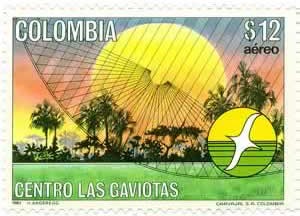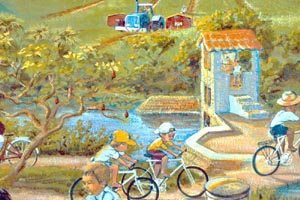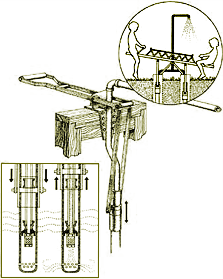9 August 2003
Gaviotas

In 1965 Paulo Lugari was flying over the impoverished Llanos Orientales, the “eastern plains” that border Venezuela. The soil of the Llanos is tough and acidic, some of the worst in Colombia. Lugari mused that if people could live here they could live anywhere.
The following year Lugari and a group of scientists, artists, agronomists and engineers took the 15-hour journey along a tortuous route from Bogota to the Llanos Orientales to settle. The local population, including the indigenous Guahibo people, familiar with the political terror and violence of the ‘white man,’ were naturally suspicious.
Nearly 40 years later, while war rages across Colombia with the help of U.S. funds, equipment, and training, the 200 residents of Gaviotas, including farmers, scientists, artists, and former street kids, have created a thriving village and environmental research center in Vichada in Los Llanos.
“Gaviotas is named after a bird that enlivens the rivers at dusk.” [source]
“They have planted millions of trees, thus regenerating an indigenous rainforest. They farm organically and use wind and solar power. Every family enjoys free housing, community meals, and schooling. There are no weapons, no police, no jail. There is no mayor.” [source]
“Gaviotas provided a chance to plan a tropical civilization from the ground up, instead of depending on technologies developed for northern climates. ‘When we import solutions from the US or Europe,’ said Lugari, founder of Gaviotas, ‘we also import their problems.’
Over the years Gaviotas technicians have installed thousands of the windmills across Colombia - in some places gaviotas is the local word for windmill.”
Around 58 types of windmill were tried and tested before the pioneers came up with determined that the distinctive ‘sunflower’ design functioned best in the plains.
 “Since Gaviotas refuses to patent inventions, preferring to share them freely, the design has been copied from Central America to Chile.
“Since Gaviotas refuses to patent inventions, preferring to share them freely, the design has been copied from Central America to Chile.
Electricity comes from a low-head turbine powered by a stream, except in the short dry season, when it is backed up by a diesel generator. ‘In 24 years we’ve learned to cover 70 percent of our food and energy needs,’ says Gonalo Bernal, administrator of Gaviotas. ‘The trees we plant more than compensate for any greenhouse gases we emit. Imagine if the rest of the world lived like us.’
Gaviotas began as a collection of researchers, students, and laborers sharing vehicles, bedding, dishes, clothes - and decisions. In time several of their families joined them and a permanent colony with individual houses emerged. Government was by consensus and unwritten rules. To limit public disorder, alcohol is confined to homes. To preserve wildlife, dogs and guns are banished. A need for police, jail, or door locks has never arisen. Anyone who violates protocol, like a storekeeper who recently admitted to overcharging, is ostracized by the community until his debt is paid. Loafers aren’t tolerated, but with wages above the Colombian minimum wage, plus free meals, medical care, schools, and housing, loafing isn’t a problem.
A techno-tour of the llanos shows how Gaviotas has revolutionized life here. The most significant invention is a simple hand pump capable of tapping aquifers six times deeper than conventional models, but requiring so little effort that children can operate it. In normal pumps a heavy piston must be raised and lowered inside a pipe. Gaviotas engineers realized they could do the reverse; leave the piston stationary and lift an outer sleeve of lightweight, inexpensive PVC tubing instead.”
 “In the open-air Gaviotas preschool, the children’s see-saw is actually a pump in disguise. As they rise and descend, water gushes from a vertical pipe into an open cement tank. Over the years Gaviotas technicians have installed these in thousands of school yards, using kid power to provide villages with clean water. This simple, inexpensive pump has revolutionised rural life across Colombia for people who used to haul their water in buckets from muddy tropical rivers.” [source]
“In the open-air Gaviotas preschool, the children’s see-saw is actually a pump in disguise. As they rise and descend, water gushes from a vertical pipe into an open cement tank. Over the years Gaviotas technicians have installed these in thousands of school yards, using kid power to provide villages with clean water. This simple, inexpensive pump has revolutionised rural life across Colombia for people who used to haul their water in buckets from muddy tropical rivers.” [source]
“At a windmill-fed cattle trough, surrounded by a sloping cement floor, cowboys have just brought several thirsty calves. As they drink, their dung slides down the slope into a gutter, which sluices it to an enclosed anaerobic fermentation tank, where the cow-pie slurry turns into compost and methane.
The methane flows through pipes to the 16-bed Gaviotas hospital, which a Japanese architectural journal has named one of the 40 most important buildings in the world. It is at once both futuristic and ancient, a maze of angles formed by white walls, glass awnings, skylights, brushed steel columns, and exposed supports trimmed in blue and yellow enamel. The interior is cooled with underground ducts whose hillside intakes face the prevailing breeze. Opposing layers of corrugated roofing create a series of air channels that further bleed away the heat. The combined effect is cost-free, maintenance-free air conditioning. Solar collectors on the roof alternately heat, boil, and distill water. Electricity is from solar photovoltaic cells.
The only hospital within a 12-hour radius, it serves all comers, including both guerrilla and army forces battling in the area. ‘The rule here is never to ask,’ says Bernal. ‘Like the Red Cross, everybody respects us.’
A short, vine-covered walkway connects the Gaviotas hospital to the maloks, a separate wing built by the local Guahivo Indians. Instead of beds, patients and their families lie in hammocks hung from wooden beams under a great thatch roof. Relatives of the sick tend crops of tomatoes, lettuce, and onions in an adjacent hydroponic greenhouse.
If the National University’s pharmacology department and the Guahivo shamans have their way, this greenhouse will one day become the finest medical plant laboratory in the tropics. But money is a critical factor, and Colombia’s expanding, government-owned oil and gas industry has dampened Gaviotas’ solar collector sales by blocking tax benefits for investing in alternative energy. At  the same time revenue from windmills and pumps dropped as Colombian agriculture was battered by an unexpected onslaught of cheap imported foods, the fallout of new free trade policies.
the same time revenue from windmills and pumps dropped as Colombian agriculture was battered by an unexpected onslaught of cheap imported foods, the fallout of new free trade policies.
So Gaviotas has decided to scale down its manufacturing. But no one is getting laid off. ‘Gaviotas isn’t a company,’ Lugari says, ‘we’re a community. In fact the solution means that both employment and Gaviotas will grow.’
The solution is the nearly 20,000 forested acres. In the past 12 years, Gaviotas has planted 1.6 million Caribbean pines (after finding that no indigenous tree would grow on the prairie). To the surprise of foresters, Gaviotans chose not to cut their standing timber. Instead they are converting their windmill factory to process pine resin. Colombia spends $4 million annually to import such resins for the manufacture of paint, turpentine, and paper. Armed with that fact, Lugari persuaded the Japanese government to provide the seed money, via a grant through the Interamerican Development Bank, to begin tapping and processing resin for the domestic market.” [source]
Since the above was written in 1995, the community no longer purhcases diesel fuel and is now totally energy independent. They generate power with turbine engines fueled by the resin of the Carribean pine trees in their forest. These pines are being slowly crowded out by the regeneration of indigenous rainforest. [source]
Other inventions include:
- a high pressure solar cooker
- methane burners
- hot-water solar panels
- parabolic solar grain driers
- self-cooling rooftops
- cooling wind corridors
- corkscrewing manual well digger
- variety of highly efficient and durable windmills
- specialized bicycle for the Llanos
- pedal powered cassava grinder (10 hours work done in 1 hour)
- rotating drum peanut sheller
- ox-drawn land graders
- one-handed sugarcane press
Gaviotas engineers also designed a solar kettle for the hospital. According to engineer Jaime Dávila, “the principle begins with an old country custom: boil water one day to drink the next, after it cools.” Dávila’s goal was an inexpensive solar-operated system that would give unlimited boiled drinking water, already cooled to room temperature, straight from a tap any time of day, and would work under cloudy skies. The kettle took six years to perfect. It combines solar panels, storage tanks, an efficient heat exchanger, a bit of distillation and a spigot — which you turn to draw off potable water.[source]
See some renderings of their solar collectors, solar oven, and wind-powered musical organ.

